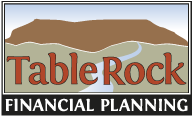 Solid academic research, along with the collective wisdom and insight of many successful investors, forms the foundation of the investment management perspective at Table Rock Financial Planning. This philosophy of investing influences the advice given to hourly financial planning customers and the portfolios we manage for clients on an on-going basis.
Solid academic research, along with the collective wisdom and insight of many successful investors, forms the foundation of the investment management perspective at Table Rock Financial Planning. This philosophy of investing influences the advice given to hourly financial planning customers and the portfolios we manage for clients on an on-going basis.
At Table Rock Financial Planning we believe in:
Managing risk and return expectations
- Investing involves risk: Understanding the financial risks you are assuming is critical to creating an investment strategy you can live with. Most people realize that in order to expect higher returns on their investments, they generally need to assume higher risks. Conversely, if a client desires to minimize investment risk, lower investment returns need to be factored into their plan and other decisions (e.g. saving more or lowering expectations of future income) may need to be aligned.
- Realistic return expectations: It is not prudent to blindly assume that markets will always produce investment returns equal to some historical average. Reasonable and conservative future expectations are essential to creating plans with a high potential of achieving goals.
- The risk and return trade-off: A key objective is to balance each client’s:
- Need to take risk—How high of returns do you need to meet your goals?
- Ability to take risk—How much risk is prudent, given your time horizon and resource levels?
- Tolerance for risk—How much downside volatility can you emotionally handle before you are losing sleep and ready to abandon your investment strategy?
Maintaining discipline and perspective
- Investor emotions: Markets go up and down, and investor emotions go with them. Things are generally never as good, or as bad, as they seem at the moment. Although we don’t advocate burying your head in the sand, we encourage tuning out popular media hysteria and maintaining a balanced perspective.
- Adherence to plan: We will encourage you to create and stick to a long term strategy, increasing the odds of you reaching your goals. Changes in strategies should only be initiated when personal circumstances and goals change, or if there is significant new information—not when emotions run high. Bear markets can be an expensive time to change strategies.
- Avoiding the performance gap: It is well documented that the average individual investor achieves much less than the average returns of the markets they invest in. This is primarily due to high costs of investing, trying to time the market, and chasing returns. We want to help investors eliminate this performance gap.
The importance of diversification and asset allocation
- Diversification: Smart investors realize the market is not going to reward you for the extra risk you take when putting “all your eggs in one basket”. To avoid over-concentration in individual stocks, bonds, industry sectors, countries, etc, we believe most people should invest through mutual funds and exchange traded funds (ETFs). If you want to play the market by making individual stock selections, we suggest it with a small, dedicated portion of your assets.
- Focus on asset allocation: At Table Rock, in accordance with Modern Portfolio Theory1, we advocate spreading investments across many different asset classes2, seeking to maximize a client’s expected return for a given, acceptable level of risk. This often means more exposure to small company stocks, foreign companies in the developed and developing world, real estate investment trusts, and different types of bonds than are found in many portfolios. Although this strategy doesn’t eliminate the risk of investing, over time it will smooth out returns and allow you to benefit from the growth in more sectors of the world economy. Asset allocation is arguably your most important investment decision.
- Stocks vs. bonds: How much of your portfolio allocation should be in defensive assets (e.g. bonds and money market) versus how much you allocate to growth assets (e.g. stocks and real estate) is the most critical asset allocation decision. Getting this right is key to designing portfolios with acceptable levels of risk and expected return.
Passive, low cost and value investing
- Index funds: At Table Rock we believe that low cost, passively managed index funds and ETFs are the most effective way to build a portfolio. It is simple, tax efficient, and the best way to ensure that you make your fair share of market returns. When actively managed funds are used, we look for low cost, no load funds that fit your asset allocation strategy.
- Value investing: Although we will allocate investments across all investment styles, we will overweight portfolios to the value side. We believe that value investing will provide superior risk adjusted returns over time.
[Top]
- Modern Portfolio Theory was pioneered by Harry Markowitz in the 1950s, and for this contribution he was awarded the Nobel Prize in Economics in 1990. Although the mathematics is somewhat daunting, the concepts are understandable (ask your financial advisor to explain it). A couple of key takeaways from MPT are that overall portfolio risk can be controlled through proper diversification and asset allocation and that the risk of individual investments is not as important as how all of the investments work together in a portfolio. An important concept from MPT is that of the efficient frontier. The efficient frontier is the locus of points representing the most efficient portfolios achievable—those providing the best possible investment return for a given level of risk.
All this theory is great—it guides the thinking of competent financial advisors and keeps countless academics employed. Unfortunately, in practice finding the efficient frontier is an elusive task. It is based on many inputs which are simply not knowable in advance. As a consequence, at Table Rock Financial Planning we strive to assemble portfolios that provide reasonably efficient risk/return trade-offs, but we don’t delude ourselves (or you) that they are optimal.
As John Bogle describes the process of putting together portfolios: “While there are complex systems that offer precise formulas for implementing the perfect asset allocation plan, the good asset allocation plan simply assumes that these nuances of investing are unpredictable… In an uncertain world—and it will be ever thus—getting your allocation almost right is better than getting it precisely wrong.”
- Examples of asset classes include:
- Stocks of large, mid-size and small U.S. corporations
- Stocks of various size corporations in other developed countries
- Stocks of various size corporations in other developing economies
- Stocks with different investment attributes or styles (value stocks vs. growth stocks)
- Bonds from different issuers (U.S. Treasury and agencies, municipal bonds, corporate foreign bonds, etc.)
- Bonds with different durations (short term, intermediate, or long term)
- Real Estate (REITs, limited partnerships, timberland, etc.)
- Commodities (gold, natural resources, agricultural, etc.)
[Top]







